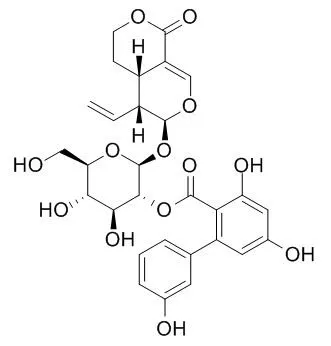| Description: |
Amarogentin incorporated in liposomes or niosomes may have clinical application in the treatment of leishmaniasis. It plays cemopreventive/therapeutic role during liver carcinogenesis through modulation of cell cycle and apoptosis. Amarogentin may offer therapeutic potential for preventing or treating thromboembolic disorders, it prevents platelet activation through the inhibition of PLC γ2-PKC cascade and MAPK pathway. |
| Targets: |
COX | PKC | MAPK | p53 | p21 | Caspase | Bcl-2/Bax | PARP | c-Myc |
| In vitro: |
| PLoS One. 2014 Mar 6;9(6):e90637. | | The bitter barricading of prostaglandin biosynthesis pathway: understanding the molecular mechanism of selective cyclooxygenase-2 inhibition by amarogentin, a secoiridoid glycoside from Swertia chirayita.[Pubmed: 24603686] | Amarogentin, a bitter secoiridoid glycoside from S. chirayita, shows varied activity in several patho-physiological conditions, predominantly in leishmaniasis and carcinogenesis. Experimental analysis has revealed that Amarogentin downregulates the cyclooxygenase-2 (COX-2) activity and helps to curtail skin carcinogenesis in mouse models; however, there exists no account on selective inhibition of the inducible cyclooxygenase (COX) isoform by Amarogentin.
METHODS AND RESULTS:
Hence the computer-aided drug discovery methods were used to unravel the COX-2 inhibitory mechanism of Amarogentin and to check its selectivity for the inducible isoform over the constitutive one. The generated theoretical models of both isoforms were subjected to molecular docking analysis with Amarogentin and twenty-one other Food and Drug Authority (FDA) approved lead molecules. The post-docking binding energy profile of Amarogentin was comparable to the binding energy profiles of the FDA approved selective COX-2 inhibitors. Subsequent molecular dynamics simulation analysis delineated the difference in the stability of both complexes, with Amarogentin-COX-2 complex being more stable after 40ns simulation. The total binding free energy calculated by MMGBSA for the Amarogentin-COX-2 complex was -52.35 KCal/mol against a binding free energy of -8.57 KCal/mol for Amarogentin-COX-1 complex, suggesting a possible selective inhibition of the COX-2 protein by the natural inhibitor. Amarogentin achieves this potential selectivity by small, yet significant, structural differences inherent to the binding cavities of the two isoforms. Hypothetically, it might block the entry of the natural substrates in the hydrophobic binding channel of the COX-2, inhibiting the cyclooxygenation step.
CONCLUSIONS:
To sum up briefly, this work highlights the mechanism of the possible selective COX-2 inhibition by Amarogentin and endorses the possibility of obtaining efficient, futuristic and targeted therapeutic agents for relieving inflammation and malignancy from this phytochemical source. | | J Antimicrob Chemother. 1999 Dec;44(6):791-4. | | Evaluation of the in-vivo activity and toxicity of amarogentin, an antileishmanial agent, in both liposomal and niosomal forms.[Pubmed: 10590280] |
METHODS AND RESULTS:
The antileishmanial property of Amarogentin, a secoiridoid glycoside isolated from the Indian medicinal plant Swertia chirata, was examined in a hamster model of experimental leishmaniasis.
The therapeutic efficacy of Amarogentin was evaluated in free and two different vesicular forms, liposomes and niosomes. The Amarogentin in both liposomal and niosomal forms was found to be a more active leishmanicidal agent than the free Amarogentin; and the niosomal form was found to be more efficacious than the liposomal form at the same membrane microviscosity level. Toxicity studies involving blood pathology, histological staining of tissues and specific enzyme levels related to normal liver function showed no toxicity.
CONCLUSIONS:
Hence, Amarogentin incorporated in liposomes or niosomes may have clinical application in the treatment of leishmaniasis. |
|
| In vivo: |
| Biomed Res Int. 2014;2014:728019. | | Amarogentin, a secoiridoid glycoside, abrogates platelet activation through PLC γ 2-PKC and MAPK pathways.[Pubmed: 24868545] | Amarogentin, an active principle of Gentiana lutea, possess antitumorigenic, antidiabetic, and antioxidative properties. Activation of platelets is associated with intravascular thrombosis and cardiovascular diseases.
METHODS AND RESULTS:
The present study examined the effects of Amarogentin on platelet activation. Amarogentin treatment (15~60 μM) inhibited platelet aggregation induced by collagen, but not thrombin, arachidonic acid, and U46619. Amarogentin inhibited collagen-induced phosphorylation of phospholipase C (PLC) γ2, protein kinase C (PKC), and mitogen-activated protein kinases (MAPKs). It also inhibits in vivo thrombus formation in mice. In addition, neither the guanylate cyclase inhibitor ODQ nor the adenylate cyclase inhibitor SQ22536 affected the Amarogentin-mediated inhibition of platelet aggregation, which suggests that Amarogentin does not regulate the levels of cyclic AMP and cyclic GMP.
CONCLUSIONS:
In conclusion, Amarogentin prevents platelet activation through the inhibition of PLC γ2-PKC cascade and MAPK pathway. Our findings suggest that Amarogentin may offer therapeutic potential for preventing or treating thromboembolic disorders. |
|






 Cell. 2018 Jan 11;172(1-2):249-261.e12. doi: 10.1016/j.cell.2017.12.019.IF=36.216(2019)
Cell. 2018 Jan 11;172(1-2):249-261.e12. doi: 10.1016/j.cell.2017.12.019.IF=36.216(2019) Cell Metab. 2020 Mar 3;31(3):534-548.e5. doi: 10.1016/j.cmet.2020.01.002.IF=22.415(2019)
Cell Metab. 2020 Mar 3;31(3):534-548.e5. doi: 10.1016/j.cmet.2020.01.002.IF=22.415(2019) Mol Cell. 2017 Nov 16;68(4):673-685.e6. doi: 10.1016/j.molcel.2017.10.022.IF=14.548(2019)
Mol Cell. 2017 Nov 16;68(4):673-685.e6. doi: 10.1016/j.molcel.2017.10.022.IF=14.548(2019)